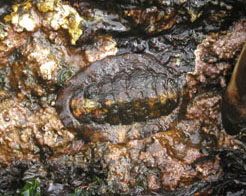


Reproduction at Eagle Cove
Reproduction by invertebrates at Eagle Cove runs the gamut from free spawning of gametes followed by a planktonic larval stage, to asexual clonal fission in anemones, to parthenogenesis, to specialized epitokous stages in nereid polychaetes, to brooding that is typical of crustaceans. Here are a few highlights of reproduction...
|
...at the Sandy Beach
|
...at the Rocky Promontory
|
...at the Cobble Beach
|

|

|

|
At the sandy beach, a surprising array of taxa with small body forms--including copepods, nematodes, gastrotrichs, polychaetes, cnidarians, and cladocerans--live "interstitially" between sand grains. How do these species reproduce in an environment that seems inhospitable for reproduction? Here are just a few examples...
|
Gastrotrichs
|

gastrotrich collected from sand |

an interstitial copepod brooding embryos 
a mysid shrimp |
Various Crustaceans
Copepods, another type of crustacean that is abundant in the sandy beach, are strictly sexual reproducers. They also keep their embryos in specialized brood sacs. |
[Reproduction Top] - [Eagle Cove Main Page]
Different types of reproduction are often associated with particular microhabitats. Here we describe invertebrate reproduction in three distinct areas (the high intertidal; the mid-intertidal/tidepools & crevices; and the low intertidal- Phyllospadix zone) that are interesting, important to understanding the community, and just plain cool!
HIGH INTERTIDAL
Barnacles
|

high barnacle density in a quadrat |
MID-INTERTIDAL, POOLS & CREVICES
Molluscs of the mid-intertidal have diverse modes of reproduction. Chitons (such as Katharina tunicata) are typically free-spawners, releasing large numbers of gametes (sperm and eggs) into the water column. Sexes are separate, so that reproduction is most effective when individuals spawn in close proximity. |


Katharina tunicata and its sperm |

Nucella egg mass between Semibalanus barnacles |
Some gastropods, including snails in the genus Nucella, lay benthic egg capsules. These snails' larvae develop completely inside the egg capsules and then hatch out as fully-formed but tiny Nucella juveniles. |
|
Other organisms found in this habitat have not one, but two modes of reproduction. The sea anemone Anthopleura elegantissima can reproduce repeatedly by asexual fissioning, where an individual will dive itself in two. The same anemone can also reproduce sexually by free-spawning, which results in pelagic, feeding planula larvae that disperse much farther than a fissioned clone. Sea anemones like A. elegantissima often form large mats of individuals, called clones, in mid-intertidal pools and crevices that stay wet at low tide. |
|
[Reproduction Top] - [Eagle Cove Main Page]
LOW-INTERTIDAL: PHYLLOSPADIX (EELGRASS) HABITAT
During the very lowest tides, one can find at the base of the rocky promontory clumps of the eelgrass Phyllospadix. Detritus and sediment accumulates in the roots of Phyllospadix, creating a unique habitat that harbors a variety of polychaetes worms (we counted 10 different polychaetes families in our quadrats), grazing snails, and juvenile crabs. Below are two examples of reproductive modes for invertebrates in our sample.
Polychaetes Benthic polychaete worms of the family Nereidae undergo a life-history transformation of the adult body into a stage called an epitoke. Epitokes are sexually mature worms that become highly specialized for swimming and releasing gametes into the water column. Spawning times are usually highly synchronized within species to improve chances for successful fertilization. Worms of the family Lumbrinaridae are also abundant in the eelgrass. Unlike the nereids, these worms do not form a specialized stage and instead deposit benthic eggs, which are brooded and may produce crawl-away juveniles that resemble adult worms. |

Head of a nereid epitoke. Notice the paddle-like parapodia modified for swimming. |

Mmmm...Donuts - a bowl full of L. vincta egg masses |
Gastropods |
[Reproduction Top] - [Eagle Cove Main Page]
Most of the invertebrates found in the cobble beach habitat are strictly sexual-reproducers, and the majority of these are crustacean brooders. (Exceptions to this pattern include some free-spawning limpets, such as Lottia scutum ).

Idotea wosnesenskii female with hatched juveniles |
Isopods and amphipods are both abundant under the loose cobble, and each have marsupium for brooding young. In the photo to the left, the young isopods being brooded, and perhaps released prematurely upon handling, are visible near the mother. |
Shore crabs (Hemigrapsus sp.), porcelain crabs (Petrolisthes sp.), and hermit crabs (Pagarus sp.) also brood their eggs, but they release free-swimming larval stages called zoea. In the plankton, the zoea increase their size by feeding and molting. As they become ready to settle, they molt into a post-larval stage called a megalopa. As you can see from the picture, megalopa look similar to a little crab with a prominent abdomen, which is reduced and tucked under the cephalothorax in adults. |

megalopa larva of Hemigrapsus sp. |
[Reproduction Top] - [Eagle Cove Main Page] - [Home]